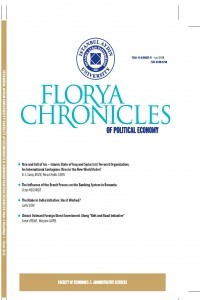Relationship Between Political Instability & Growth In Some Selected Mena Countries
Relationship Between Political Instability & Growth In Some Selected Mena Countries
The presence of a relationship between political instability and economic growth are hotly debated issues in the sphere of political economy. In this study, the purpose is to make an analysis, in the field of political economy, regarding the effect of political variables on the growth in case of MENA (Algeria, Egypt, Iran, Jordan, Lebanon, Morocco and Tunisia) countries. The reason why these seven countries were chosen is their demographic, cultural and economic proximity. To find evidence and proof for the study’s hypothesis, range political and economic variables were employed. The study aims to find the high degree relationship between political instability and economic growth by using Least Square Dummy Variable estimation for linear dynamic panel data model on a sample covering up to seven MENA countries for the years starting from 1990 to 2012
Keywords:
Economic Growth, MENA Countries Political Instability,
___
- A Review Essay on Persson and Tabellini’s The Economic Effect on Constitutions. National Bureau of Economic Research, 9-29. Affect cfm?abstract_id=1560524. Growth?, http://papers.ssrn.com/sol3/papers.
- A Critical Survey of the Recent Literature and Some New Results’’, http:// wber.oxfordjournals.org/content/8/3/351.short. Stability and Investment, http://www.sciencedirect.com/science/article/ pii/0014292195000305.
- Instability And Economic Growth, http://link.springer.com/article/10.1007/ BF00138862. on Economic Growth Developing Countries. Sosyo Ekonomi, (1), 285- the Case of Turkey. Ege Academic Review, 11(1). of Countries. Annals of Economics and Finance, (4), 234-274.
- Unbalanced Panel-Data Models with Small Number of Individuals. The Stata Journal, 5(4), 473-500. Doğan, A., (2005), Demokrasi Ve Ekonomik Gelişme. Erciyes
- Üniversitesi İktisadi ve İdari Bilimler Fakültesi Dergisi, (25), 1-15. Drukker, D., (2003), Testing for Serial Correlation in Linear Panel
- Data Models. The Stata Journals, 3(2), 168-177. Hoyos, R., Vasilis, S., (2006), Testing for Cross-Sectional
- Dependence in Panel Data Models. The Stata Journal, 6(4), 482-496. Ismihan, M., Kivilcim, M. O., Aysit, T., (2005), The Role of
- Macroeconomic Instability in Public and Private Capital Accumulation and Growth: the Case of Turkey 1963-1999. Applied Economics, (35), 55-120.
- Mankiw, N. G., David, R., David, N. W., (1992), a Contribution to the Empirics of Economic Growth, the Quarterly Journal of Economics, (2), 424-433.
- Penn World Table, (2014), http://cid.econ.ucdavis.edu/data.html.
- Shepherd, B., (2014), Political Stability: Crucial for Growth’’, http:// www2.lse.ac.uk/IDEAS/publications/reports/pdf/SU004/shepherd.pdf.
- Solow, R., (1956), A Contribution to the Theory of Economic
- Growth. the Quarterly Journal of Economics, 70(1), 65-91. Wahman, M., Teorell, J, Hadenius, A., (2013), Authoritarian
- Regime Types Data Set. Contemporary Politics, 19(1), 19-34. World Bank, (2017), https://data.worldbank.org/data-catalog/ world-development-indicators.
- ISSN: 2149-5750
- Yayın Aralığı: Yılda 2 Sayı
- Başlangıç: 2015
- Yayıncı: İstanbul Aydın Üniversitesi
Sayıdaki Diğer Makaleler
Psikolojik Sermaye Kavramı Üzerine Bir İnceleme
Lord Curzon and the Use of Secret Intelligence at the Lausanne Conference: 1922-1923
Political Violence and Terrorism: Insight Into Niger Delta Militancy and Boko Haram
Özüm Sezin UZUN, Yusuf Saheed ADEGBOYEGA
Turkey’s Education Diplomacy With Africa
Development as Systems: Systems Frameworks, Sub-Saharan African Development, and Health Systems
Economic Development In Africa: Salient Trends and Priorities
Sanal Organizasyonların Yönetim Fonksiyonları Açısından Geleneksel Organizasyonlardan Farklılıkları
Food Security And Drawbacks Of Neo-Liberal Food Policies
Relationship Between Political Instability & Growth In Some Selected Mena Countries
